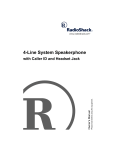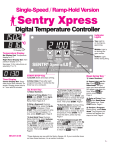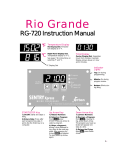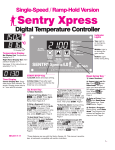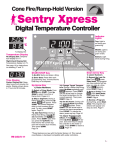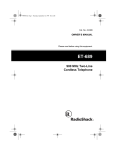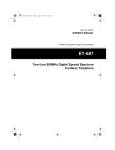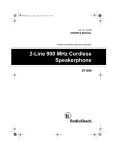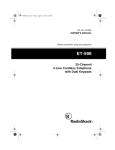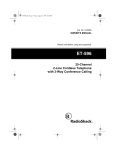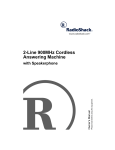Download Radio Shack and Speakerphone Owner`s manual
Transcript
43-461.fm Page 1 Friday, August 13, 1999 8:52 AM Cat. No. 43-461 OWNER’S MANUAL Please read before using this equipment. SYSTEM 612 4-Line Speakerphone 43-461.fm Page 2 Friday, August 13, 1999 8:52 AM FEATURES Your RadioShack System 612 4-Line Speakerphone gives you a complete four-line telephone system with the most advanced features available. You can connect up to four telephone numbers to up to 12 different System 612 Speakerphones and use each phone as an extension telephone station for making and receiving calls. Note: Adding another type of telephone device to the same telephone lines used by your System 612 might cause the System 612’s features (and the added phone’s features) to not work properly. Redial and Auto Redial — lets you quickly dial the last-dialed number with the press of a button, or set that station to automatically redial the last dialed number up to ten times, so you can concentrate on your work instead of having to repeatedly dial a number until you get an answer. Conference Calling — lets you conduct 3-way conversations with two callers or with one caller and one other station at the same time. Flash — sends an electronic switchhook signal for use with special phone services such as call waiting. The System 612’s features include: Four-Line Telephone System — lets you connect the Speakerphone to up to four telephone lines. Liquid Crystal Display — displays the date, time, call time, the phone or extension number you dialed, and other helpful information. Built-In Intercom with All Call Paging — lets you call an individual station, or page all stations at the same time. DND (Do Not Disturb) — lets you block all incoming and intercom calls and pages so your current call is not interrupted. Hold Button — lets you put a call on hold, so you can answer another call or page an extension. Memory Dialing — lets you store up to 40 telephone numbers in memory so you can quickly dial them by pressing only one or two number buttons. Speakerphone — allows hands-free telephone conversations. Pulse/Tone Option — lets you use your phone with either type of service. Hearing Aid Compatible — lets you use your telephone with hearing aids that have a T (telephone) switch. © 1996, 1998 Tandy Corporation. All Rights Reserved. RadioShack is a registered trademark used by Tandy Corporation. 2 43-461.fm Page 3 Friday, August 13, 1999 8:52 AM This telephone is ETL listed to UL standards and meets all applicable FCC standards. Note: The System 612 Speakerphone requires three AAA batteries to protect numbers stored in memory in case of a power failure. For your records, we recommend you record the telephone’s serial number here. The number is on the bottom of the telephone. Serial Number __________________ WARNING: To reduce the risk of fire or shock hazard, do not expose this product to rain or moisture. READ THIS BEFORE INSTALLATION We have designed your telephone to conform to federal regulations, and you can connect it to most telephone lines. However, each device you connect to the phone line draws power from it. This power draw is the device’s Ringer Equivalence Number, or REN. The REN is on the bottom of the telephone. If you use more than one phone or other device on the line, add up all the RENs. If the total is more than five (or three in rural areas), your phone(s) might not ring and your answering machine might not answer. If ringer operation is impaired, remove one of the devices from the line. CAUTION RISK OF ELECTRIC SHOCK. DO NOT OPEN. ! CAUTION: TO REDUCE THE RISK OF ELECTRIC SHOCK, DO NOT REMOVE COVER OR BACK. NO USER-SERVICEABLE PARTS INSIDE. REFER SERVICING TO QUALIFIED PERSONNEL. This symbol is intended to alert you to the presence of uninsulated dangerous voltage within the Speakerphone’s enclosure that might be of sufficient magnitude to constitute a risk of electric shock. Do not open the Speakerphone’s case. ! This symbol is intended to inform you that important operating and maintenance instructions are included in the literature accompanying this Speakerphone. FCC STATEMENT Your telephone complies with Part 68 of FCC Rules. You must, upon request, provide the FCC registration number and the REN to your telephone company. Both numbers are on the bottom of the telephone. Note: You must not connect the telephone to: • Coin-operated systems • Party-line systems • Most electronic key telephone systems 3 43-461.fm Page 4 Friday, August 13, 1999 8:52 AM CONTENTS Installing the Speakerphone ................................................................................. 6 Installing the Backup Batteries .......................................................................... 7 Selecting a Location .......................................................................................... 7 Placing the Phone on a Desk Top ............................................................... 8 Mounting the Phone on a Wall .................................................................... 9 Connecting the Handset ................................................................................... 11 Setting the Speakerphones’ Station Extension Numbers ................................ 12 Setting the Dialing Mode ................................................................................. 12 Setting the Date and Time ............................................................................... 13 Adjusting the Ringer Volume ........................................................................... 14 Using the Telephone ............................................................................................ Line Status ....................................................................................................... Line Lock ......................................................................................................... Making a Call with the Handset ....................................................................... Making a Call with the Speakerphone ............................................................. Answering a Call .............................................................................................. Switching Between the Handset and the Speakerphone ................................ Using Hold ....................................................................................................... Using Privacy ................................................................................................... Using Flash ...................................................................................................... Using Redial .................................................................................................... Using Auto Redial ............................................................................................ Using the Timer ............................................................................................... Conference Calling .......................................................................................... With Two Outside Callers .......................................................................... With One Outside Caller and One Internal Station ................................... Using DND (Do Not Disturb) ............................................................................ Using Tone Services on a Pulse Line .............................................................. Memory Dialing ................................................................................................ Storing a Number into Memory ................................................................. Entering a Pause ...................................................................................... Dialing Stored Numbers ............................................................................ Chain-Dialing Service Numbers ................................................................ Testing Stored Emergency Numbers ........................................................ 15 15 15 15 15 16 16 16 17 17 17 18 18 19 19 19 20 20 20 20 22 22 22 22 Using Intercom and Paging ................................................................................ Making an Intercom Call .................................................................................. Answering an Intercom Call ............................................................................. Paging One Station ......................................................................................... Paging All Stations .......................................................................................... 23 23 24 24 25 4 43-461.fm Page 5 Friday, August 13, 1999 8:52 AM Answering a Page ............................................................................................ 25 Transferring a Call ............................................................................................ 25 Troubleshooting ................................................................................................... 26 Care and Maintenance ......................................................................................... 27 The FCC Wants You to Know .............................................................................. 28 Lightning ........................................................................................................... 28 5 43-461.fm Page 6 Friday, August 13, 1999 8:52 AM INSTALLING THE SPEAKERPHONE To fully use the Speakerphone’s features, you must connect it to two separate telephone lines, each with its own telephone number. However, you can connect it to a single line. • If you do not have 2-line phone jacks, you can use 1-line modular phone jacks or combine up to four 1line modular phone jacks using 2line couplers (such as RadioShack Cat. No. 279-401, not supplied). Notes: • If you connect two or more Speakerphones, they must all be connected to the same Line 1 telephone number. • The first Speakerphone you connect to Line 1 is automatically set to Extension 11. Any additional Speakerphones you connect to Line 1 will ring and display EXT 00 until you set a new extension number (see “Setting the Speakerphones’ Station Extension Numbers” on Page 12). • You must connect the Speakerphone to the telephone lines before you plug in its AC adapter. Otherwise, each station will have the same extension number and the paging and intercom features will not work until you properly set all extensions (see “Setting the Speakerphones’ Station Extension Numbers” on Page 12). • You can connect your Speakerphone directly to one or two 2-line modular phone jacks. 6 • If your phone line jacks are not modular jacks, you can update the wiring yourself, using jacks and adapters available at your local RadioShack store. Or, you can have the phone company update the wiring for you. • The USOC number of the two-line jack to be installed is RJ14C (or RJ14W for a wall plate jack). The USOC number for a single-line jack is RJ11C (or RJ11W for a wall plate jack). 43-461.fm Page 7 Friday, August 13, 1999 8:52 AM INSTALLING THE BACKUP BATTERIES symbols (+ and –) marked inside the battery compartment. The System 612 requires AC power to operate. However, if AC power fails or you unplug the speakerphone, the three AAA backup batteries (not supplied) save stored information. We recommend you use alkaline batteries, such as RadioShack Cat. No. 23-555. Cautions: • Always use fresh batteries of the required size and type. • Do not mix old and new batteries, different types of batteries (standard, alkaline, or rechargeable), or rechargeable batteries of different capacities. • Disconnect the System 612 from the phone line(s) before replacing the backup batteries. Notes: • To avoid losing stored information when replacing the batteries, leave the AC adapter plugged in, and have fresh batteries ready to install before removing the old ones. • Replace the batteries when BATT appears. 1. Use a Phillips screwdriver to remove the screw from the battery compartment cover, then remove the cover. 2. Install three AAA batteries (not supplied) as indicated by the polarity 3. Replace the cover and the screw. Cautions: • Always remove old or weak batteries. Batteries can leak chemicals that can destroy electronic parts. • Dispose of old batteries promptly and properly. SELECTING A LOCATION You can place the Speakerphone on a on a desk top, shelf, or table, mount it directly on a wall, or mount it on a standard wall plate. Select a location that is: • near an AC outlet • near the desired telephone line jack(s) • out of the way of normal activities • away from electrical machinery, electrical appliances, metal walls or filing cabinets, wireless intercoms, alarms, and room monitors 7 43-461.fm Page 8 Friday, August 13, 1999 8:52 AM Placing the Phone on a Desk Top Follow these steps when you place the base on a desk, shelf, or table. 3. Plug one end of the other supplied modular cord into the L3&4 jack on the bottom of the phone, then route the cord through the TELEPHONE LINE(S) slot. 1. Remove the stand from the bottom of the phone by pressing and holding in both spring tabs, then gently pulling the wide end of the stand and lifting it off. 2. Plug one end of one of the supplied modular cords into the L1&2 jack on the bottom of the phone, then route the cord through the TELEPHONE LINE(S) slot. 8 4. Insert the supplied AC adapter’s barrel plug into the jack on the bottom of the telephone, then route the AC power cord through the AC ADAPTER CORD slot. Do not plug the adapter into the AC outlet at this time. 43-461.fm Page 9 Friday, August 13, 1999 8:52 AM Caution: The supplied AC adapter supplies 12V DC, delivers at least 300 mA, and has a plug that properly fits the telephone’s jack. Using an adapter that does not meet these specifications might damage the telephone or the adapter. 5. Insert the tabs on the narrow end of the supplied stand into the upper slots near the center of the phone, push the wide end of the stand until it clicks into place, then place the Speakerphone on the desk. 6. Plug the modular cords’ other ends into the modular phone line jack(s) for Lines 1 through 4, then plug the AC adapter into a standard AC outlet. INITIALIZING 01 briefly appears, then JAN 12:00 AM EXT 11 FRI appears. Mounting the Phone on a Wall You can mount your telephone on a wall plate, or you can mount it directly on the wall using two screws (not supplied) with heads that fit into the keyhole slots on the bottom of the telephone. If you are mounting the phone directly on the wall, drill two holes 315/16 inches (100 mm) apart. Thread the two screws into the wall, letting the heads extend about 3/16 inch (5 mm). 1. Remove the stand from the bottom of the phone by pressing and holding in both spring tabs, then gently pulling the wide end of the stand and lifting it off. 9 43-461.fm Page 10 Friday, August 13, 1999 8:52 AM 2. Insert the tabs on the narrow end of the supplied stand upward into the lower slots near the center of the phone, push the wide end of the stand until it clicks into place. 3. Plug one end of one of the supplied modular line cords into the L1&2 jack on the bottom of the phone, then route the cord through the TELEPHONE LINE(S) slot. 4. Plug one end of the other supplied line cord into the L3&4 jack on the bottom of the phone, then route the cord through the TELEPHONE LINE(S) slot. 10 5. Insert the supplied AC adapter’s barrel plug into the jack on the bottom of the telephone, then route the AC power cord through the AC ADAPTER CORD slot. Do not plug the adapter into the AC outlet at this time. Caution: The supplied AC adapter supplies 12V DC, delivers at least 300 mA, and has a plug that properly fits the telephone’s jack. Using an adapter that does not meet these specifications might damage the telephone or the adapter. 43-461.fm Page 11 Friday, August 13, 1999 8:52 AM 8. Lift out the handset holder, rotate it 180°, then snap it back into place so it holds the handset. 6. Plug the modular cords’ other ends into the modular phone line jack(s) for Lines 1 through 4, then plug the AC adapter into a standard AC outlet. 7. Align the keyhole slots on the back of the stand with the wall plate studs (or the screws in the wall), then carefully slide the phone down to secure it. CONNECTING THE HANDSET Plug one end of the coiled cord into the modular jack on the handset. Then connect it to the jack on the side of the base. Place the handset in the cradle. You might prefer a longer cord for the handset. Your local RadioShack store has a wide selection of telephone accessories, including longer coiled handset cords. 11 43-461.fm Page 12 Friday, August 13, 1999 8:52 AM SETTING THE SPEAKERPHONES’ STATION EXTENSION NUMBERS When you connect more than one Speakerphone, you must also set a different extension number for each station so you can use the paging and intercom features. SETTING THE DIALING MODE Follow these steps to set the phone for the type of service you have — tone or pulse. At each Speakerphone station: 1. Press PROGRAM. pears. 2. Press 1. Press PROGRAM. pears. 2. Press , then MEMORY ap- #. 3. Enter the extension number (11-22) you want to assign to that station. 4. Press INTERCOM to store the number. The speakerphone rings once. Note: If you try to set up a Speakerphone with an extension number that has already been used for another station, the speakerphone rings and displays EXT 00 until you select an available extension number. 12 , #, then MEMORY apagain. 3. Press 0 if you have tone service or 1 if you have pulse service. 4. Press PRIVACY to store the setting. The phone rings once. 43-461.fm Page 13 Friday, August 13, 1999 8:52 AM SETTING THE DATE AND TIME To set the date and time, you must use the format MMDDWHHMMA. For example, to set December 25, Thursday, 3:30 PM, enter 122550330#. Use this table to find the values used by your telephone. Month (MM) 01 — January 02 — February 03 — March 04 — April 05 — May 06 — June 07 — July 08 — August 09 — September 10 — October 11 — November 12 — December Date (DD) Weekday (W) Hour (HH) Minute (MM) 01–31 1 — Sunday 2 — Monday 3 — Tuesday 4 — Wednesday 5 — Thursday 6 — Friday 7 — Saturday 01–12 00–59 To make it easier to enter the current month, date, weekday, hour, minute, and AM or PM, first write the corresponding values here. MM DD W HH MM AM/PM (A) = AM # = PM Follow these steps to set the time and date. 1. Press CLOCK/FORWARD. 00:00 6 00:00 AM appears on the display. A Notes: • You must enter two digits for the month, date, hour, and minute. • This clock uses the 12-hour format. AM or PM appears on the display. 2. Enter the values as you recorded them in the table on the left. The telephone rings after you enter the last setting. 13 43-461.fm Page 14 Friday, August 13, 1999 8:52 AM Notes: If you make an invalid entry (such as 13 for the month), the previously stored time and date reappear. If this happens, start over at Step 1. ADJUSTING THE RINGER VOLUME This Speakerphone has four ringer volume levels — off, low, middle, and high — for each line. To adjust a line’s ringer volume, when that line rings, simply press VOLUME or VOLUME . Note: If more than one line is ringing at or the same time, pressing VOLUME VOLUME adjusts the ringer volume for all lines. 14 43-461.fm Page 15 Friday, August 13, 1999 8:52 AM USING THE TELEPHONE LINE STATUS The line status indicators to the left of each line button show that line’s status. To line lock your call again, press the line button again. A double ring sounds and all other internal stations are disconnected (if they joined your call) and locked out. MAKING A CALL WITH THE HANDSET Indicator Status 1. Lift the handset. The telephone automatically selects an available line, or press a line button to select that line. Off Not in use 2. Dial the number. Flashes twice every 2 seconds In use 3. When the call is over, hang up the handset to disconnect the call. Flashes once every 2 seconds Incoming call Flashes twice every second A call on hold Flashes once every second A call is on hold at another station MAKING A CALL WITH THE SPEAKERPHONE LINE LOCK Each time you pick up the handset or press SPKR PHONE to make or answer a call, the speakerphone’s line-lock feature automatically locks out all other internal stations from using that line. You can release the line lock and let any other stations join in the call by pressing the line button. A single ring sounds and other stations can join in the call. 1. Press SPKR PHONE. You hear the dial tone. 2. Dial the number. 3. If necessary during the call, press VOLUME or VOLUME to increase or decrease the speakerphone’s volume level. 15 43-461.fm Page 16 Friday, August 13, 1999 8:52 AM 4. When the call is over, press SPKR PHONE again to disconnect the call. ANSWERING A CALL USING HOLD To place a call on hold, press HOLD. You can then hang up the handset or use the other phone line without disconnecting the current call. To answer an incoming call, pick up the handset or press SPKR PHONE . Note: If another station answers an incoming call before you do, your station is locked out and you hear either the dial tone from the another phone line, or silence if all other lines are being used by other stations. To end the call, place the handset back on the cradle or press SPKR PHONE again. SWITCHING BETWEEN THE HANDSET AND THE SPEAKERPHONE To switch from the speakerphone to the handset, just lift the handset. The speakerphone automatically turns off. To switch from the handset to the speakerphone, first press SPKR PHONE , then place the handset on the cradle. (Be sure to press SPKR PHONE before replacing the handset, or the call will be disconnected.) Note: When you use the speakerphone, only one party can talk over the phone line at a time. 16 When you put a call on hold, line lock is cancelled so you can put a call on hold at one station and pick up the call on another station. To pick up a line that is on hold, simply press that line’s button. You can alternate between two lines by pressing HOLD to put your current line on hold, then pressing the button for the line you want to pick up. Note: If you press another line’s button without first pressing HOLD, the first call is disconnected. 43-461.fm Page 17 Friday, August 13, 1999 8:52 AM USING PRIVACY If you do not want the person on the other end of the phone line to hear your conversation with someone else at your location, press PRIVACY. The PRIVACY indicator lights and the microphone turns off, but you can still hear the calling party. Note: If you do not have any special phone services, pressing FLASH might disconnect the current call. USING REDIAL You can quickly redial the last number you dialed from that station. • To use the handset, lift it then press PAUSE/REDIAL when you hear the dial tone. • To use the speakerphone, press SPKR PHONE then PAUSE/REDIAL. The privacy feature is automatically activated. Press PRIVACY again to resume your conversation. USING FLASH FLASH performs the electronic equiva- lent of a switchhook operation for special services, such as Call Waiting. The Speakerphone automatically selects an available line and dials the number. Notes: • The redial memory holds up to 31 digits, so you can redial long-distance as well as local phone numbers. • When you redial a phone number that includes a PULSE/TONE mode change, the phone pauses for about 2 seconds at the point where you set PULSE/TONE (see “Using Tone Services on a Pulse Line” on Page 20). For example, if you have Call Waiting, press FLASH to put your current call on hold and answer an incoming call without disconnecting the current call. Press FLASH again to alternate between the two calls. • When you redial a phone number that includes a FLASH entry, the phone only redials the numbers you pressed after FLASH. 17 43-461.fm Page 18 Friday, August 13, 1999 8:52 AM USING AUTO REDIAL USING THE TIMER You can set your Speakerphone to automatically redial a number up to ten times. The telephone’s timer displays elapsed time in minutes and seconds, up to 59 minutes and 59 seconds. This helps you track how long each call lasts. 1. While the handset is on the cradle and SPKR PHONE is off, press an available line’s button. 2. Press PAUSE/REDIAL. The SPKR PHONE indicator flashes and the PRIVACY indicator lights. To start the timer, press TIMER/BACK00:00 appears on the display, then the timer starts counting. WARD. The Speakerphone redials the number up to ten times, every 30 seconds. 3. When the person answers, pick up the handset or press SPKR PHONE . This cancels auto redial. To cancel auto redial while the phone is redialing, simply press PAUSE/REDIAL again. Note: Be sure to cancel auto redial if you leave the area of your telephone. Otherwise, your Speakerphone will continue to hang up and redial up to 10 times at 30 second intervals, even if someone answers. 18 Note: After the timer reaches 59 minutes, 59 seconds, it starts counting again from 0 minutes, 0 seconds unless you stop it. To stop the timer, press TIMER/BACKWARD again. The display automatically returns to the current time display within 6 seconds after you stop the timer or hang up the phone. 43-461.fm Page 19 Friday, August 13, 1999 8:52 AM CONFERENCE CALLING both calls on hold (see “Using Hold” on Page 16). Conference calling lets you conduct 3way conversations with two outside callers, or with one outside caller and one or more other internal stations. To start the conference call again, while both calls are on hold, pick up one of the calls then press CONFERENCE. With Two Outside Callers Follow these steps to have a conference call with two outside callers. 1. Place the first call on hold by pressing HOLD. 2. Place or answer a call on any of the other three lines. 3. With the second call connected, press CONFERENCE. All three parties are connected. With One Outside Caller and One or More Internal Stations Follow these steps to have a conference call with one outside caller and any or all other internal stations. 1. Place the outside caller on hold by pressing HOLD. 2. Press INTERCOM and dial the station number you want to join your call. 3. When the station answers, press CONFERENCE. All three parties are connected. To end the conference call, simply hang up. To disconnect one of the callers from the conference call, simply press the line button for the caller you want to have stay on the line. To end the conference call and talk to both callers individually, press HOLD. This ends the conference call and puts Or, you can release the line-lock and let another station join in the call. Simply press the line button for the current call. After a short ring sounds, someone at another station can join your call by picking up the handset or pressing SPKR PHONE, then pressing the appropriate LINE button. To disconnect the other station and reengage line-lock, simply press the line button. A double ring sounds and the other internal station is disconnected. Note: Only the station that released linelock can re-engage it. 19 43-461.fm Page 20 Friday, August 13, 1999 8:52 AM USING DND (DO NOT DISTURB) You can lock out all incoming calls and pages when you do not want to be disturbed. Simply press DND/DELETE. DND appears on the display and your Speakerphone does not accept incoming calls, intercom calls, or pages (see “Using Intercom and Paging” on Page 23). But, you can still make calls and use the intercom from your telephone. To release DND, simply press DND/DELETE again. Notes: • If you call a station that is using DND, you hear a busy signal. • If you are using DND when an intercom call comes in, the intercom indicator blinks rapidly and the caller’s number appears on the display. If you choose to answer the call, press INTERCOM . USING TONE SERVICES ON A PULSE LINE Some special services, such as bank-byphone, require tone signals. If you have pulse service, you can still use these special tone services by following these steps. Dial the service’s main number as usual, then simply press TONE/ when the 20 service answers. Any additional keys you press are sent as tone signals. After you complete the call, hang up the handset or press SPKR PHONE. The phone automatically resets to pulse dialing. MEMORY DIALING You can store up to 40 numbers in the Speakerphone’s memory locations. Then you can quickly dial these numbers by pressing one or two buttons. Each number you store can be up to 15 digits long. Storing a Number into Memory Each of the phone’s 20 memory locations can have up to 2 phone numbers stored in it — into either an upper or lower memory position. Notes: • Leave the handset in the cradle when you store numbers. 43-461.fm Page 21 Friday, August 13, 1999 8:52 AM • To prevent unauthorized access to special services, we recommend you do not store a personal identification number in memory. 1. Press PROGRAM. pears. • For a lower memory position, press LOWER, then a memory button. MEMORY ap- The telephone rings and stores the number. Note: A double ring sounds if you made an error in storing the number or if the number exceeds 15 digits. If this happens, begin again at Step 1. 2. Enter the number you want to store, including any pause/redial or flash entries (see “Entering a Pause” on Page 22 or “Using Flash” on Page 17). Notes: Use a flat-blade screwdriver to lift up the plastic cover from the telephone number index card. For each stored number, write the person’s or company’s name next to the appropriate memory location number and upper or lower position on the phone number index card. Use a pencil in case you want to change it later. • To store the last number you dialed, simply press PAUSE/ REDIAL. • If you make a mistake while entering the number, start again from Step 1. 3. Select the memory location where you want to store the number. • For an upper memory position, simply press a memory button. 21 43-461.fm Page 22 Friday, August 13, 1999 8:52 AM To clear a number stored in an upper memory position, press PROGRAM then the desired memory location button. To clear a number stored in a lower memory position, press PROGRAM, LOWER then the desired memory location button. The telephone rings once to indicate the number is cleared. Entering a Pause In some telephone systems, you must dial an access code (9, for example) and wait for a second dial tone before you can dial an outside number. You can store the access code with the phone number; however, you must also store a pause after the access code to allow the outside line time to connect. To enter a 2-second pause, press PAUSE/REDIAL. For a longer pause, press PAUSE/REDIAL additional times. Note: You must enter at least one digit before you can store a pause. Dialing Stored Numbers To dial a number stored in memory, lift the handset or press SPKR PHONE. To use a line other than 1, press the line button. Then: • To dial a number stored in an upper memory position, press the desired memory location button. 22 • To dial a number stored in a lower memory position, press LOWER then the desired memory location button. Chain-Dialing Service Numbers For quick recall of numbers for special services (such as alternate long distance or bank by phone), store each group of numbers in its own memory location. To use the stored special service information, dial the service’s main number first. Then, at the appropriate place in the call, press LOWER (if necessary) then the button for the location where the additional information is stored. Testing Stored Emergency Numbers If you store an emergency service’s number (police department, fire department, ambulance) and you choose to test the stored number, make the test call during the late evening or early morning hours to avoid peak demand periods. Also, remain on the line to explain the reason for your call. 43-461.fm Page 23 Friday, August 13, 1999 8:52 AM USING INTERCOM AND PAGING You can call other stations connected to the same phone line using either the intercom or paging feature. Using the Speakerphone’s intercom feature is like making a telephone call to another station. You can conduct a twoway conversation when the called station answers. 1. To use the intercom with the speakerphone, press INTERCOM. ICM appears on the display and the speakerphone turns on and sounds a steady tone. Using the Speakerphone’s paging feature is like making public address (PA) announcements. You can announce your message directly to one or all the stations instead of making the stations ring. • If no station answers, your page is like making a one-way call. • When a station answers, your page changes into an intercom call. MAKING AN INTERCOM CALL Before you make an intercom call, check the intercom status indicator to be sure no one else is using the intercom. Indicator Status Off Not in use On steadily In use by another station Flashes rapidly Receiving an intercom call Flashes twice every 2 seconds In use/Making an intercom call To use the intercom with the handset, lift the handset, then press INTERCOM . 2. Within 10 seconds, enter the extension number (11 –22) for the station you want to call. That station’s intercom indicator blinks rapidly, and that station sounds a double ring. Notes: • If the called party does not answer your intercom call, you can change the intercom call to a page to that station by pressing PAGE . 23 43-461.fm Page 24 Friday, August 13, 1999 8:52 AM • If you do not dial the extension number within 10 seconds after pressing INTERCOM, the telephone sounds two rings and you must redial. To answer the intercom call, lift the handset, or turn on the speakerphone by pressing INTERCOM. To release the intercom call, press SPKR PHONE or hang up the handset. • You can use the upper memory position buttons to dial an extension number. For example, use the first position’s button to automatically dial extension 11, and the next button to automatically dial extension 12. Note: If you are using the DND feature when an intercom call comes in, the intercom indicator blinks rapidly and the calling party’s number appears on the display. To answer the call, press INTERCOM. • If the called station’s DND (Do Not Disturb) feature is activated, or the called station is busy, your telephone sounds an intercom busy signal. • An intercom call to one station can be answered by any other station. PAGING ONE STATION 1. To page another phone using the speakerphone, press PAGE. PAGE appears on the display and the speakerphone turns on and sounds an intercom tone. 3. When the person answers, talk into the speakerphone or pick up the handset. 4. To end an intercom call, press SPKR PHONE or hang up the handset. ANSWERING AN INTERCOM CALL When someone makes an intercom call to your extension, the telephone sounds a double ring, the calling party’s number appears on the display, and the intercom indicator blinks rapidly. (If you are on the phone, the ring’s volume is reduced.) 24 2. Enter the desired extension number. Your Speakerphone rings and displays the number you are calling. 43-461.fm Page 25 Friday, August 13, 1999 8:52 AM The called station displays PAGE and your extension number, its PRIVACY indicator lights to show its microphone is turned off, and its speaker automatically turns on. 3. Lift the handset and speak your announcement, or just talk into the speakerphone. Note: You can change an individual page to an intercom call by pressing INTERCOM. Note: When a page is sent to all stations, as soon as any one station answers, all other stations are automatically locked out. TRANSFERRING A CALL If a caller asks to speak to someone at another extension, you can transfer the call either by using the intercom or by paging. 1. Press HOLD to place the call on hold. PAGING ALL STATIONS 1. Press PAGE then . Your phone rings once and displays PAGE ALL , and INTERCOM flashes. All other stations display PAGE ALL BY and your extension number, the INTERCOM indicator lights, and the speakers automatically turn on. 2. Press INTERCOM (or PAGE ). The INTERCOM indicator flashes. 3. Dial the extension number. 4. When the person answers, tell the person which line to pick up, then hang up the handset or press SPKR PHONE. 2. Lift the handset and speak your announcement, or just talk into the speakerphone. 3. To end a page call, press SPKR PHONE or hang up the handset. ANSWERING A PAGE To answer a page to your Speakerphone, either lift the handset or press PRIVACY, then start talking. To answer a page to all stations, lift the handset and press PAGE, then start talking. 25 43-461.fm Page 26 Friday, August 13, 1999 8:52 AM TROUBLESHOOTING We do not expect you to have any problems with your Speakerphone, but if you do, these suggestions might help: • Be sure the Speakerphone is properly connected to the telephone line(s). • Be sure TONE/PULSE is correctly set. • Be sure the AC adapter is properly connected. • Be sure you have connected the same telephone number to the same line at every station. • Be sure fresh batteries are installed in the Speakerphone. • If your Speakerphone does not work or works poorly, check its connection to the phone line. Phone calls are automatically switched and routed through complex equipment. You will occasionally connect to a weak line. In some cases you might have to hang up and dial the number again. • If you have problems completing a call using redial or memory dialing, try manually dialing the phone number. You might have made a mistake when you dialed or stored the number. 26 If you still have problems, disconnect the Speakerphone. If other phones on the same line function properly, the problem is in the Speakerphone or its installation. If you are unable to locate the problem, take the Speakerphone to your local RadioShack store for assistance. 43-461.fm Page 27 Friday, August 13, 1999 8:52 AM CARE AND MAINTENANCE Your RadioShack System 612 4-Line Speakerphone is an example of superior design and craftsmanship. The following suggestions will help you care for the Speakerphone so you can enjoy it for years. Keep the Speakerphone dry. If it gets wet, wipe it dry immediately. Liquids might contain minerals that can corrode the electronic circuits. Handle the Speakerphone gently and carefully. Dropping it can damage circuit boards and cases and can cause it to work improperly. Use and store the Speakerphone only in normal temperature environments. Temperature extremes can shorten the life of electronic devices and distort or melt plastic parts. Keep the Speakerphone away from dust and dirt, which can cause premature wear of parts. Wipe the Speakerphone with a damp cloth occasionally to keep it looking new. Do not use harsh chemicals, cleaning solvents, or strong detergents to clean the system. Modifying or tampering with the Speakerphone’s internal components can cause a malfunction and might invalidate your Speakerphone’s warranty and void your FCC authorization to operate it. If your Speakerphone is not performing as it should, take it to your local RadioShack store for assistance. If the trouble is affecting the phone lines, the phone company might ask you to disconnect your Speakerphone until you have resolved the problem. 27 43-461.fm Page 28 Friday, August 13, 1999 8:52 AM THE FCC WANTS YOU TO KNOW In the unlikely event that your Speakerphone causes problems on the telephone line, the telephone company attempts to notify you in advance. If advance notice is not practical, the telephone company notifies you as soon as possible and advises you of your right to file a complaint with the FCC. Also, the telephone company can make changes to its lines, equipment, operations, or procedures that could affect the operation of this system. The telephone company notifies you of these changes in advance so you can take the necessary steps to prevent interruption of your telephone service. Your Speakerphone complies with the limits for a Class B digital device as specified in Part 15 of FCC Rules. These limits provide reasonable protection against radio and TV interference in a residential area. However, your Speakerphone might cause TV or radio interference even when it is operating properly. To eliminate interference, you can try one or more of the following corrective measures: • Reorient or relocate the receiving radio or TV antenna. • Increase the distance between the Speakerphone and the radio or TV. • Use outlets on different electrical circuits for the Speakerphone and the radio or TV. 28 Consult your local RadioShack store if the problem still exists. The Service Order Code (SOC) is 9.0F, the Facility Interface Code (FIC) is O2LS2. This equipment is capable of providing users access to interstate providers of operator services through the use of access codes. Modification of this equipment by call aggregators to block access to dialing codes is a violation of the Telephone Operator Consumers Act of 1990. LIGHTNING Your Speakerphone has built-in protection circuits to reduce the risk of damage from surges in telephone and power line current. These protection circuits meet or exceed the FCC requirements. However, lightning striking the telephone or power lines can damage your system. Lightning damage is not common. Nevertheless, to reduce the possibility of damage if you live in an area that has severe electrical storms, we recommend you unplug the System 612 Speakerphone during lightning storms to reduce the possibility of damage. 43-461.fm Page 29 Friday, August 13, 1999 8:52 AM The backup batteries hold the setup selections in memory as long as the batteries are fully charged. If the date, time, and extension number do not appear on the display after you re-connect a speakerphone, replace the batteries, then repeat the steps in “Setting the Speakerphone’s Station Extension Numbers” and “Setting the Dialing Mode” on Page 12, and “Setting the Date and Time” on Page 13. 29 43-461.fm Page 30 Friday, August 13, 1999 8:52 AM NOTES 30 43-461.fm Page 31 Friday, August 13, 1999 8:52 AM 31 43-461.fm Page 32 Friday, August 13, 1999 8:52 AM Limited One-Year Warranty This product is warranted by RadioShack against manufacturing defects in material and workmanship under normal use for one (1) year from the date of purchase from RadioShack company-owned stores and authorized RadioShack franchisees and dealers. EXCEPT AS PROVIDED HEREIN, RadioShack MAKES NO EXPRESS WARRANTIES AND ANY IMPLIED WARRANTIES, INCLUDING THOSE OF MERCHANTABILITY AND FITNESS FOR A PARTICULAR PURPOSE, ARE LIMITED IN DURATION TO THE DURATION OF THE WRITTEN LIMITED WARRANTIES CONTAINED HEREIN. EXCEPT AS PROVIDED HEREIN, RadioShack SHALL HAVE NO LIABILITY OR RESPONSIBILITY TO CUSTOMER OR ANY OTHER PERSON OR ENTITY WITH RESPECT TO ANY LIABILITY, LOSS OR DAMAGE CAUSED DIRECTLY OR INDIRECTLY BY USE OR PERFORMANCE OF THE PRODUCT OR ARISING OUT OF ANY BREACH OF THIS WARRANTY, INCLUDING, BUT NOT LIMITED TO, ANY DAMAGES RESULTING FROM INCONVENIENCE, LOSS OF TIME, DATA, PROPERTY, REVENUE, OR PROFIT OR ANY INDIRECT, SPECIAL, INCIDENTAL, OR CONSEQUENTIAL DAMAGES, EVEN IF RadioShack HAS BEEN ADVISED OF THE POSSIBILITY OF SUCH DAMAGES. Some states do not allow the limitations on how long an implied warranty lasts or the exclusion of incidental or consequential damages, so the above limitations or exclusions may not apply to you. In the event of a product defect during the warranty period, take the product and the RadioShack sales receipt as proof of purchase date to any RadioShack store. RadioShack will, at its option, unless otherwise provided by law: (a) correct the defect by product repair without charge for parts and labor; (b) replace the product with one of the same or similar design; or (c) refund the purchase price. All replaced parts and products, and products on which a refund is made, become the property of RadioShack. New or reconditioned parts and products may be used in the performance of warranty service. Repaired or replaced parts and products are warranted for the remainder of the original warranty period. You will be charged for repair or replacement of the product made after the expiration of the warranty period. This warranty does not cover: (a) damage or failure caused by or attributable to acts of God, abuse, accident, misuse, improper or abnormal usage, failure to follow instructions, improper installation or maintenance, alteration, lightning or other incidence of excess voltage or current; (b) any repairs other than those provided by a RadioShack Authorized Service Facility; (c) consumables such as fuses or batteries; (d) cosmetic damage; (e) transportation, shipping or insurance costs; or (f) costs of product removal, installation, set-up service adjustment or reinstallation. This warranty gives you specific legal rights, and you may also have other rights which vary from state to state. RadioShack Customer Relations, Dept. W, 100 Throckmorton St., Suite 600, Fort Worth, TX 76102 We Service What We Sell 3/97 RadioShack A Division of Tandy Corporation Fort Worth, Texas 76102 3A8 Printed in Singapore
































